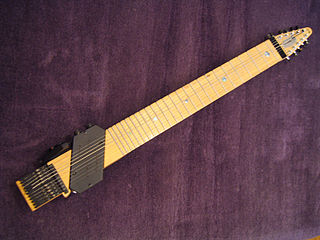
String instruments, stringed instruments, or chordophones are musical instruments that produce sound from vibrating strings when the performer plays or sounds the strings in some manner.

Pizzicato is a playing technique that involves plucking the strings of a string instrument. The exact technique varies somewhat depending on the type of instrument:
Hornbostel–Sachs or Sachs–Hornbostel is a system of musical instrument classification devised by Erich Moritz von Hornbostel and Curt Sachs, and first published in the Zeitschrift für Ethnologie in 1914. An English translation was published in the Galpin Society Journal in 1961. It is the most widely used system for classifying musical instruments by ethnomusicologists and organologists. The system was updated in 2011 as part of the work of the Musical Instrument Museums Online (MIMO) Project.

The Chapman Stick is an electric musical instrument devised by Emmett Chapman in the early 1970s. A member of the guitar family, the Chapman Stick usually has ten or twelve individually tuned strings and has been used on music recordings to play bass lines, melody lines, chords, or textures. Designed as a fully polyphonic chordal instrument, it can also cover several of these musical parts simultaneously.

Tapping is a guitar playing technique where a string is fretted and set into vibration as part of a single motion of being tapped onto the fretboard, with either hand, as opposed to the standard technique of fretting with one hand and picking with the other.

Emmett Chapman is an American jazz musician best known as the inventor of the Chapman Stick and maker of the Chapman Stick family of instruments.

Matched grip is a method of holding drum sticks and mallets to play percussion instruments. In the matched grip each hand holds its stick in the same way, whereas in the traditional grip, each hand holds the stick differently. Almost all commonly used matched grips are overhand grips. Specific forms of the grip are French grip, German grip, and American grip.
Tap guitar is a class of guitar that is played primarily by tapping on the strings. Any guitar can be played this way, but there are various specialty brands of instruments that are designed specifically for this technique.
In classical guitar, the right hand is developed in such a way that it can sustain two, three, and four voice harmonies while also paying special attention to tone production. The index (i), middle (m), and ring (a) fingers are generally used to play the melody, while the thumb (p) accompanies in the bass register adding harmony, and produces a comparable texture and effect to that of the piano. The classical guitar is one of the very few solo polyphonic instruments, and is notoriously difficult to master.

A flamenco guitar is a guitar similar to a classical guitar but with thinner tops and less internal bracing. It is used in toque, the guitar-playing part of the art of flamenco.
Michael Masley is known for his musical work on the Hungarian cymbalom. His unique method of playing the instrument comes from his invention of the bowhammer, a cross between a fiddle bow and a dulcimer hammer, attached to the finger with a ring. Since 1983, Masley has made his living as a street musician, busking and selling cassette and CD recordings on the streets of Berkeley, San Francisco, and other San Francisco Bay Area locations.
The Megatar is a stringed musical instrument designed to be played with two-handed tapping. It is manufactured by the U.S. company 'Mobius Megatar'.
String instruments are capable of producing a variety of extended technique sounds. These alternative playing techniques have been used extensively since the 20th century. Particularly famous examples of string instrument extended technique can be found in the music of Krzysztof Penderecki, Witold Lutosławski, George Crumb, and Helmut Lachenmann.
Guitar picking is a group of hand and finger techniques a guitarist uses to set guitar strings in motion to produce audible notes. These techniques involve plucking, strumming, brushing, etc. Picking can be done with:

The StarrBoard is a stringed musical instrument invented by John D. Starrett and patented on July 23, 1985.

Experimental luthiers are luthiers who take part in alternative stringed instrument manufacturing or create original string instruments altogether.
The harpejji is an electric stringed musical instrument developed in 2007 by Tim Meeks, founder of Marcodi Musical Products, and is a descendant of the StarrBoard. The instrument aims to bridge the gap in sound and technique between the guitar, bass guitar, and piano. The playing surface has an isomorphic keyboard layout arranged in ascending whole tones across strings, and ascending semi-tones as the strings travel away from the player with a five octave range from A0 to A5. The first harpejji model, the 24 string d1, was produced from January 2008 through May 2010. It was subsequently replaced by the k24 which also has 24 strings. The latter model includes updates to the internal electronics, a simplification of the fretboard marker system, and a change from maple to bamboo as the primary wood for the instrument. In January 2011, the g16, a smaller 16 string model with a four octave range and mono output, was introduced. All harpejjis use an electronic muting system to dampen unfretted strings and minimize the impact of sympathetic vibrations.

The Veena is the primary name of specific Ancient musical instruments evolved into many variations, such as lutes, zithers and arched harps. The many regional designs have different names such as the Rudra veena, the Saraswati veena, the Vichitra veena and others.

The Warr Guitar is an American-made "touch" guitar, a type of instrument that combines both bass and melodic strings on a single fretboard. It is related to the Chapman Stick, another two-handed tapping instrument. The Warr Guitar is designed for either two-handed tapping or strumming. Warr Guitars have between seven and 14 strings.










